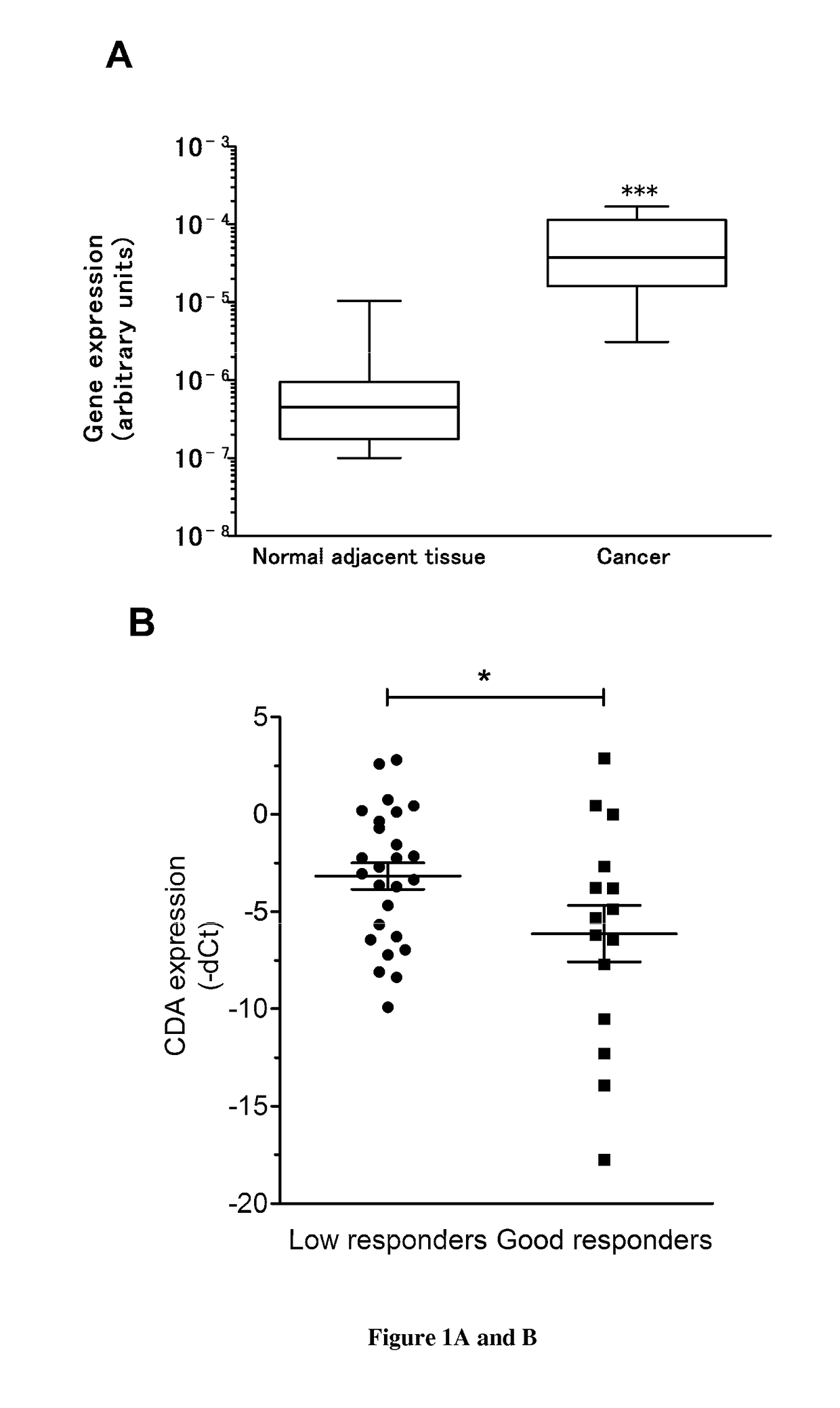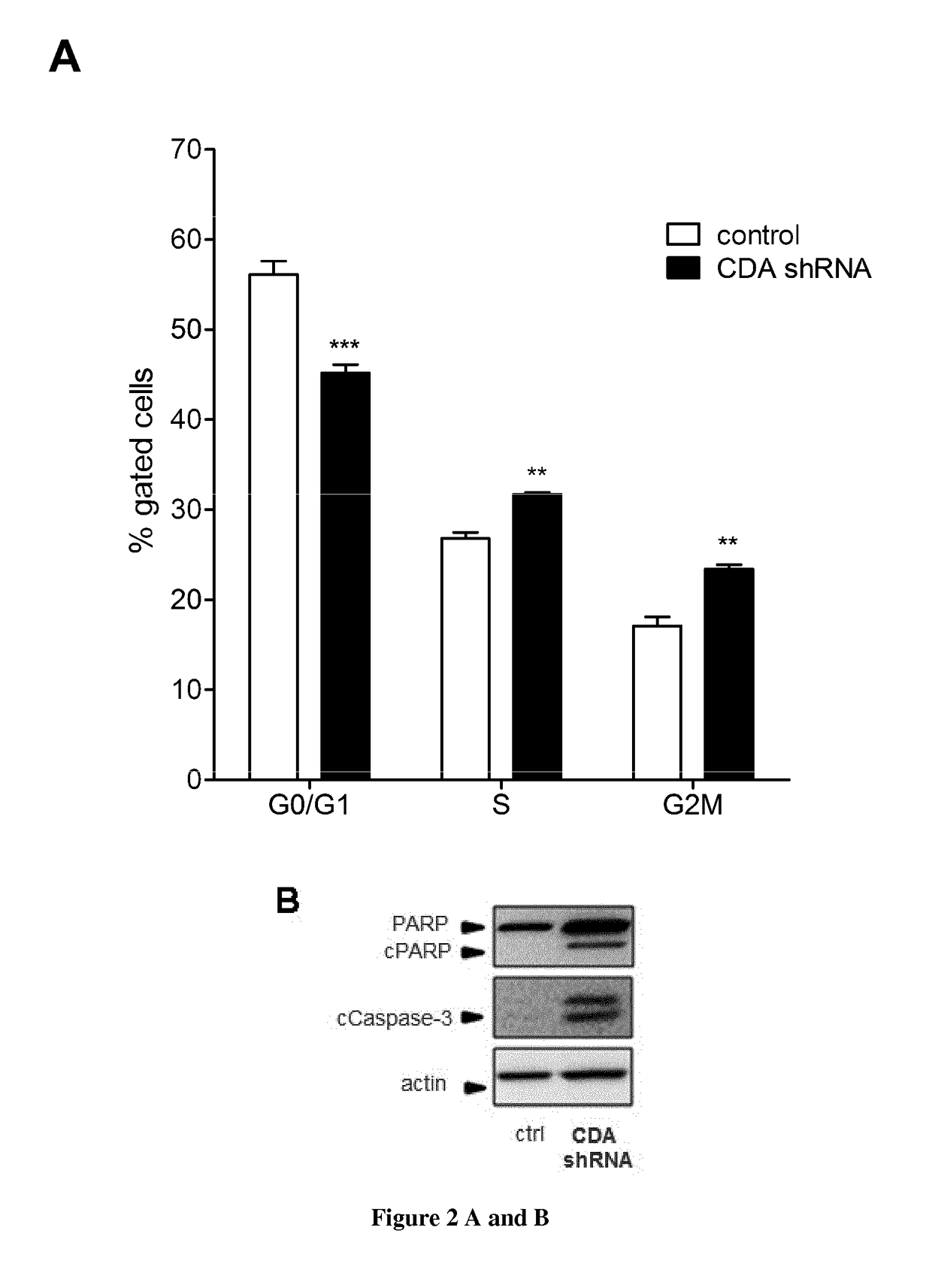Cytidine deaminase inhibitors for the treatment of pancreatic cancer
a technology of cytidine deaminase inhibitors and pancreatic cancer, which is applied in the direction of instruments, drug compositions, genetic material ingredients, etc., can solve the problems of poor long-term survival after surgery
- Summary
- Abstract
- Description
- Claims
- Application Information
AI Technical Summary
Benefits of technology
Problems solved by technology
Method used
Image
Examples
example 1
[0075]Pancreatic ductal carcinoma (PDA) is the most common type of pancreatic cancer Despite decades of intense efforts from researchers and clinicians, PDA remains a challenge to treat, with 5 year rates survival lower than 6% for subjects with cancers of all stages. Most PDA is identified at a late stage, when surgical intervention is not possible. Even with complete resection and negative results from analyses of tumour margins, long-term survival after surgery is poor; tumors recur in virtually all subjects. To put this into perspective, PDA is estimated to become one of the top three leading cause of cancer-related death by 20302.
[0076]Progress in the treatment of PDA has been incremental. Arguably, combination cytotoxic therapies such as FOLFIRINOX3, along with gemcitabine4 and albumin-bound paclitaxel5, have provided meaningful gains, but there is lot of needs for improvement. The only targeted agents approved in the treatment of PDA is the EGFR inhibitor Erlotinib (Tarceva),...
example 2
[0081]As described above, we found that PDA tumors expressed high levels of CDA compared to normal parenchyma and that targeting CDA in human PDA-derived cells strongly alters cell proliferation and tumor progression. Invasive PDA arises through multistage genetic and histologic progression from microscopic precursor lesions designated as pancreatic intraepithelial neoplasia (PanIN) that are believed to develop and progress asymptomatically over several decades18,19. An early event during malignant transformation is the acquisition of activating mutations in the KRAS oncogene which occurs in >90% of subjects with PDA20. PDA are highly “addicted” to this oncogene for multiple parameters influencing tumour initiation, progression and maintenance as demonstrated using genetically engineered mouse (GEM) models21. We obtained results showing that CDA is upregulated at the mRNA level in human pancreatic cells transformed by the KRAS oncogene (FIG. 6). We obtained preliminary data strongly...
example 3
[0082]Our results demonstrate that targeting CDA in PDA cells results in alterations in both S-phase progression and energetic metabolism.
[0083]Rapid and accurate DNA replication is critical for cell proliferation and for the faithful transmission of genetic information to daughter cells. Proliferating cells are continuously exposed to a variety of events impeding the progression of replication forks, commonly referred to as replication stress (RS). Sources of RS include DNA lesions of endogenous or exogenous origin and regions of the genome that are intrinsically difficult to replicate, such as highly-transcribed genes, secondary DNA structures and tightly-bound protein-DNA complexes40,41. Arrested replication forks represent a major source of genomic instability and RS has been implicated in various aspects of the cancer process. Cells exposed to acute RS activate a DNA-Damage-Response (DRR) when the fork collapse, and an ATR / Chk1-dependent checkpoint pathway known as the DNA repl...
PUM
 Login to View More
Login to View More Abstract
Description
Claims
Application Information
 Login to View More
Login to View More - R&D
- Intellectual Property
- Life Sciences
- Materials
- Tech Scout
- Unparalleled Data Quality
- Higher Quality Content
- 60% Fewer Hallucinations
Browse by: Latest US Patents, China's latest patents, Technical Efficacy Thesaurus, Application Domain, Technology Topic, Popular Technical Reports.
© 2025 PatSnap. All rights reserved.Legal|Privacy policy|Modern Slavery Act Transparency Statement|Sitemap|About US| Contact US: help@patsnap.com



